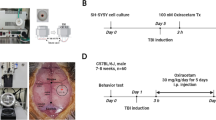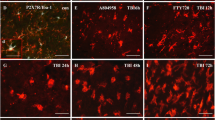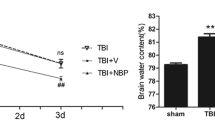Abstract
8-Methoxypsoralen (8-MOP) has anti-inflammatory, antioxidant and tissue-repairing abilities. Here, we probed the function and mechanism of 8-MOP in traumatic brain injury (TBI). The in-vivo TBI model was constructed in Sprague-Dawley (SD) rats using controlled cortical impact (CCI) surgery. In parallel, BV2 microglia and HT22 neurons were activated by lipopolysaccharide (LPS) to establish an in-vitro model. The modified neurological score (mNSS) and the Morris water maze experiment were employed to evaluate the rats’ neurological functions. The rats’ brain edema was assessed by the dry and wet method, and neuronal apoptosis in damaged brain tissues was monitored by terminal deoxynucleotidyl transferase-mediated dUTP-biotin nick end labeling (TUNEL) and Nissl’s staining. Immunohistochemistry (IHC) was applied to verify Iba1-microglial activation in brain lesions of rats. The expression of inflammatory cytokines in BV2 microglia and HT22 neurons in the injured lesion of TBI rats was examined by the enzyme-linked immunosorbent assay (ELISA). The levels of iNOS, COX2, TLR4, PPARγ, STAT3, and NF-κB in brain lesions, BV2 microglia and HT22 neurons were compared by Western blot. As a result, 8-MOP administration reduced inflammation and LPS-induced neuronal damage in BV2 microglia. In vivo, 8-MOP treatment relieved neurological deficits in TBI rats, improved cognitive, learning and motor functions and mitigated brain edema and neuroinflammation induced by TBI. Furthermore, LPS or TBI activated the NF-κB and STAT3 pathways and repressed the PPARγ expression. However, 8-MOP treatment attenuated NF-κB and STAT3 phosphorylation and elevated PPARγ levels. Hence, 8-MOP exerts neuroprotective and anti-inflammatory effects in TBI rats by modulating the PPARγ/NF-κB pathway.







Similar content being viewed by others
Data Availability
The data sets used and analyzed during the current study are available from the corresponding author on reasonable request.
Code Availability
Not applicable.
References
Hu Z, Yu D, Almeida-Suhett C, Tu K, Marini AM, Eiden L, Braga MF, Zhu J, Li Z (2012) Expression of miRNAs and their cooperative regulation of the pathophysiology in traumatic brain injury. PLoS ONE 7(6):e39357
Corrigan F, Mander KA, Leonard AV, Vink R (2016) Neurogenic inflammation after traumatic brain injury and its potentiation of classical inflammation. J Neuroinflammation 13(1):264
Kumar A, Henry RJ, Stoica BA, Loane DJ, Abulwerdi G, Bhat SA, Faden AI (2019) Neutral sphingomyelinase inhibition alleviates LPS-induced microglia activation and neuroinflammation after experimental traumatic brain injury. J Pharmacol Exp Ther 368(3):338–352
Kumar A, Stoica BA, Loane DJ, Yang M, Abulwerdi G, Khan N, Kumar A, Thom SR, Faden AI (2017) Microglial-derived microparticles mediate neuroinflammation after traumatic brain injury. J Neuroinflammation 14(1):47
McNeely W, Goa KL (1998) 5-Methoxypsoralen. A review of its effects in psoriasis and vitiligo. Drugs 56(4):667–690
Kirsch G, Abdelwahab AB, Chaimbault P (2016) Natural and synthetic coumarins with effects on inflammation. Molecules 21(10):1322
Kurach Ł, Kulczycka-Mamona S, Kowalczyk J, Skalicka-Woźniak K, Boguszewska-Czubara A, El Sayed N, Osmani M, Iwaniak K, Budzyńska B (2021) Mechanisms of the procognitive effects of xanthotoxin and umbelliferone on LPS-induced amnesia in mice. Int J Mol Sci 22(4):1779. https://doi.org/10.3390/ijms22041779
Li X, Yu C, Hu Y, Xia X, Liao Y, Zhang J, Chen H, Lu W, Zhou W, Song Z (2018) New Application of psoralen and angelicin on periodontitis with anti-bacterial, anti-inflammatory, and osteogenesis effects. Front Cell Infect Microbiol 8:178
Mukohda M (2019) Role of PPARγ, a transcription factor in cardiovascular disease. Nihon Yakurigaku Zasshi 154(2):56–60
Mitchell S, Vargas J, Hoffmann A (2016) Signaling via the NFκB system. Wiley Interdiscip Rev Syst Biol Med 8(3):227–241
Kaur S, Nag A, Singh AK, Sharma K (2018) PPARγ-targeting potential for radioprotection. Curr Drug Targets 19(15):1818–1830
Chen J, Xuan Y, Chen Y, Wu T, Chen L, Guan H, Yang S, He J, Shi D, Wang Y (2019) Netrin-1 alleviates subarachnoid haemorrhage-induced brain injury via the PPARγ/NF-KB signalling pathway. J Cell Mol Med 23(3):2256–2262
Song MT, Ruan J, Zhang RY, Deng J, Ma ZQ, Ma SP (2018) Astragaloside IV ameliorates neuroinflammation-induced depressive-like behaviors in mice via the PPARγ/NF-κB/NLRP3 inflammasome axis. Acta Pharmacol Sin 39(10):1559–1570
Henn A, Lund S, Hedtjärn M, Schrattenholz A, Pörzgen P, Leist M (2009) The suitability of BV2 cells as alternative model system for primary microglia cultures or for animal experiments examining brain inflammation. Altex 26(2):83–94. doi: https://doi.org/10.14573/altex.2009.2.83
Rusinek K, Sołek P, Tabęcka-Łonczyńska A, Koziorowski M, Mytych J (2020) Focus on the role of klotho protein in neuro-immune interactions in HT-22 cells upon LPS stimulation. Cells 9(5):1231. https://doi.org/10.3390/cells9051231
Ryu KY, Lee HJ, Woo H, Kang RJ, Han KM, Park H, Lee SM, Lee JY, Jeong YJ, Nam HW, Nam Y, Hoe HS (2019) Dasatinib regulates LPS-induced microglial and astrocytic neuroinflammatory responses by inhibiting AKT/STAT3 signaling. J Neuroinflammation 26(1):190. https://doi.org/10.1186/s12974-019-1561-x
Liu ZH, Chen NY, Tu PH, Wu CT, Chiu SC, Huang YC, Lim SN, Yip PK (2020) DHA attenuates cerebral edema following traumatic brain injury via the reduction in blood-brain barrier permeability. Int J Mol Sci 21(17):6291
Kokiko-Cochran ON, Michaels MP, Hamm RJ (2008) Delayed glucose treatment improves cognitive function following fluid-percussion injury. Neurosci Lett 436(1):27–30
Yan EB, Hellewell SC, Bellander BM, Agyapomaa DA, Morganti-Kossmann MC (2011) Post-traumatic hypoxia exacerbates neurological deficit, neuroinflammation and cerebral metabolism in rats with diffuse traumatic brain injury. J Neuroinflammation 8:147
Yu N, Hu S, Hao Z (2018) Benificial effect of stachydrine on the traumatic brain injury induced neurodegeneration by attenuating the expressions of Akt/mTOR/PI3K and TLR4/NFκ-B pathway. Transl Neurosci 9:175–182
Yuan Y, Yang J, Zhu W, Liu T, He J, Zhou Q, Zhou X, Zhang X (2018) Qianlongtong inhibits proliferation and induces apoptosis of hyperplastic prostate cells. Am J Mens Health 12(5):1548–1553
Wang L, Song LF, Chen XY, Ma YL, Suo JF, Shi JH, Chen GH (2019) MiR-181b inhibits P38/JNK signaling pathway to attenuate autophagy and apoptosis in juvenile rats with kainic acid-induced epilepsy via targeting TLR4. CNS Neurosci Ther 25(1):112–122
Jha RM, Kochanek PM, Simard JM (2019) Pathophysiology and treatment of cerebral edema in traumatic brain injury. Neuropharmacology 145(Pt B):230–246
Yang Y, Ye Y, Kong C, Su X, Zhang X, Bai W, He X (2019) MiR-124 enriched exosomes promoted the M2 polarization of microglia and enhanced hippocampus neurogenesis after traumatic brain injury by inhibiting TLR4 pathway. Neurochem Res 44(4):811–828
Hung TH, Shyue SK, Wu CH, Chen CC, Lin CC, Chang CF, Chen SF (2017) Deletion or inhibition of soluble epoxide hydrolase protects against brain damage and reduces microglia-mediated neuroinflammation in traumatic brain injury. Oncotarget 8(61):103236–103260
Borst K, Dumas AA, Prinz M (2021) Microglia immune and non-immune functions. Immunity 54(10):2194–2208. https://doi.org/10.1016/j.immuni.2021.09.014
Fu R, Shen Q, Xu P, Luo JJ, Tang Y (2014) Phagocytosis of microglia in the central nervous system diseases. Mol Neurobiol 49(3):1422–1434. https://doi.org/10.1007/s12035-013-8620-6
An J, Chen B, Kang X, Zhang R, Guo Y, Zhao J, Yang H (2020) Neuroprotective effects of natural compounds on LPS-induced inflammatory responses in microglia. Am J Transl Res 12(6):2353–2378
Levi G, Minghetti L, Aloisi F (1998) Regulation of prostanoid synthesis in microglial cells and effects of prostaglandin E2 on microglial functions. Biochimie 80(11):899–904. https://doi.org/10.1016/s0300-9084(00)88886-0
Xu H, Wang Z, Li J, Wu H, Peng Y, Fan L, Chen J, Gu C, Yan F, Wang L, Chen G (2017) The polarization states of microglia in TBI: a new paradigm for pharmacological intervention. Neural Plast 2017:5405104. https://doi.org/10.1155/2017/5405104.
He Y, Qu S, Wang J, He X, Lin W, Zhen H, Zhang X (2012) Neuroprotective effects of osthole pretreatment against traumatic brain injury in rats. Brain Res 1433:127–136
Kong L, Yao Y, Xia Y, Liang X, Ni Y, Yang J (2019) Osthole alleviates inflammation by down-regulating NF-κB signaling pathway in traumatic brain injury. Immunopharmacol Immunotoxicol 41(2):349–360
Nicolis E, Lampronti I, Dechecchi MC, Borgatti M, Tamanini A, Bezzerri V, Bianchi N, Mazzon M, Mancini I, Giri MG, Rizzotti P, Gambari R, Cabrini G (2009) Modulation of expression of IL-8 gene in bronchial epithelial cells by 5-methoxypsoralen. Int Immunopharmacol 9(12):1411–1422
Yang IJ, Lee DU, Shin HM (2015) Anti-inflammatory and antioxidant effects of coumarins isolated from Foeniculum vulgare in lipopolysaccharide-stimulated macrophages and 12-O-tetradecanoylphorbol-13-acetate-stimulated mice. Immunopharmacol Immunotoxicol 37(3):308–317
Li J, Yin P, Gong P, Lv A, Zhang Z, Liu F (2019) 8-Methoxypsoralen protects bovine mammary epithelial cells against lipopolysaccharide-induced inflammatory injury via suppressing JAK/STAT and NF-κB pathway. Microbiol Immunol 63(10):427–437
Zhao L, Zhang L, Zhu W, Chen H, Ding Y, Cui G (2021) Inhibition of microRNA-203 protects against traumatic brain injury induced neural damages via suppressing neuronal apoptosis and dementia-related molecues. Physiol Behav 228:113190. https://doi.org/10.1016/j.physbeh.2020.113190
Zhang L, Zhao L, Zhu W, Ding Y, Chen H, Chi N (2020) miR-146a mimics ameliorates traumatic brain injury involving JNK and NF-κB signaling pathway. Neuromolecul Med 22(4):484–492. https://doi.org/10.1007/s12017-020-08599-y
Li D, Huang S, Yin Z, Zhu J, Ge X, Han Z, Tan J, Zhang S, Zhao J, Chen F, Wang H, Lei P (2019) Increases in miR-124-3p in microglial exosomes confer neuroprotective effects by targeting fip200-mediated neuronal autophagy following traumatic brain injury. Neurochem Res 44(8):1903–1923. https://doi.org/10.1007/s11064-019-02825-1
Pardridge WM (2012) Drug transport across the blood-brain barrier. J Cereb Blood Flow Metab 32(11):1959–1972. https://doi.org/10.1038/jcbfm.2012.126
Wohlfart S, Gelperina S, Kreuter J (2012) Transport of drugs across the blood-brain barrier by nanoparticles. J Control Release 161(2):264–273. https://doi.org/10.1016/j.jconrel.2011.08.017
Zhang TT, Li W, Meng G, Wang P, W Liao (2016) Strategies for transporting nanoparticles across the blood-brain barrier. Biomater Sci 4(2):219–229. https://doi.org/10.1039/c5bm00383k
Liu C, Zhong L, Tian XL, Han YC (2018) Protective effects of 8-MOP on blood-brain barrier via the Nrf-2/HO-1 pathway in mice model of cerebral infarction. Eur Rev Med Pharmacol Sci 22(13):4278–4287. https://doi.org/10.26355/eurrev_201807_15424.
Villapol S (2018) Roles of Peroxisome Proliferator-Activated Receptor Gamma on Brain and Peripheral Inflammation. Cell Mol Neurobiol 38(1):121–132
Shen CH, Stavnezer J (1998) Interaction of stat6 and NF-kappaB: direct association and synergistic activation of interleukin-4-induced transcription. Mol Cell Biol 18(6):3395–3404
Wang LH, Yang XY, Zhang X, Farrar WL (2005) Nuclear receptors as negative modulators of STAT3 in multiple myeloma. Cell Cycle 4(2):242–245
Qi L, Jacob A, Wang P, Wu R (2010) Peroxisome proliferator activated receptor-γ and traumatic brain injury. Int J Clin Exp Med 3(4):283–292
Lee H, Herrmann A, Deng JH, Kujawski M, Niu G, Li Z, Forman S, Jove R, Pardoll DM, Yu H (2009) Persistently activated Stat3 maintains constitutive NF-kappaBactivity in tumors. Cancer Cell 15(4):283–93. https://doi.org/10.1016/j.ccr.2009.02.015
Jiang Q, Chen J, Long X, Yao X, Zou X, Yang Y, Huang G, Zhang H (2020) Phillyrin protects mice from traumatic brain injury by inhibiting the inflammation of microglia via PPARγ signaling pathway. Int Immunopharmacol 79:106083
Deng Y, Jiang X, Deng X, Chen H, Xu J, Zhang Z, Liu G, Yong Z, Yuan C, Sun X, Wang C (2019) Pioglitazone ameliorates neuronal damage after traumatic brain injury via the PPARγ/NF-κB/IL-6 signaling pathway. Genes Dis 7(2):253–265
Mello BSF, Chaves Filho AJM, Custódio CS, Cordeiro RC, Miyajima F, de Sousa FCF, Vasconcelos SMM, de Lucena DF, Macedo D (2018) Sex influences in behavior and brain inflammatory and oxidative alterations in mice submitted to lipopolysaccharide-induced inflammatory model of depression. J Neuroimmunol 320:133–142. https://doi.org/10.1016/j.jneuroim.2018.04.009
Chinese Head Trauma Study Collaborators (2021) Chinese head trauma data bank : effect of gender on the outcome of patients with acute traumatic brain injury. J Neurotrauma 38(8):1164–1167. https://doi.org/10.1089/neu.2011.2134
Renner C, Hummelsheim H, Kopczak A, Steube D, Schneider HJ, Schneider M, Kreitschmann-Andermahr I, Jordan M, Uhl E, Stalla GK (2012) The influence of gender on the injury severity, course and outcome of traumatic brain injury. Brain Inj 26(11):1360–1371. https://doi.org/10.3109/02699052.2012.667592.
DeMaster D, Johnson C, Juranek J, Ewing-Cobbs L (2017) Memory and the hippocampal formation following pediatric traumatic brain injury. Brain Behav 7(12):e00832. https://doi.org/10.1002/brb3.832
Funding
This research did not receive any specific grant from funding agencies in the public, commercial, or not- for- profit sectors.
Author information
Authors and Affiliations
Contributions
Conceived and designed the experiments: HZ. Performed the experiments: YH, HZ. Statistical analysis: LS. Wrote the paper: YH, HZ. All authors read and approved the final manuscript.
Corresponding author
Ethics declarations
Conflict of interest
The authors declare that they have no competing interests.
Ethical Approval
Our study was approved by the ethic committee of Liaocheng People’s Hospital (Approve No: LC-H2019039).
Consent for Publication
Not applicable.
Additional information
Publisher’s Note
Springer Nature remains neutral with regard to jurisdictional claims in published maps and institutional affiliations.
Supplementary Information
Below is the link to the electronic supplementary material.
Supplementary material 1 (XLSX 22.0 kb)
The analysis result of F, df and P-values for the ANOVA factors and interactions in Figs. 4, 5 and 6
Rights and permissions
Springer Nature or its licensor (e.g. a society or other partner) holds exclusive rights to this article under a publishing agreement with the author(s) or other rightsholder(s); author self-archiving of the accepted manuscript version of this article is solely governed by the terms of such publishing agreement and applicable law.
About this article
Cite this article
Hui, Y., Zhao, H., Shi, L. et al. Traumatic Brain Injury-Mediated Neuroinflammation and Neurological Deficits are Improved by 8-Methoxypsoralen Through Modulating PPARγ/NF-κB Pathway. Neurochem Res 48, 625–640 (2023). https://doi.org/10.1007/s11064-022-03788-6
Received:
Revised:
Accepted:
Published:
Issue Date:
DOI: https://doi.org/10.1007/s11064-022-03788-6




